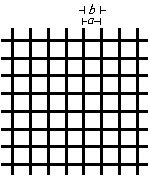 |
We wish to use the brightness and spacing of the diffraction pattern to determine the intensity of the flare that creates it. This is often necessary because the flare is so bright that it saturates the 4096 capacity of the Analog to Digital Converter (ADC) of the CCD camera. This method will allow us to greatly increase the effective intensity range of the telescope.
We observed such a flare on May 16, 1999 at 13:49:21 UT. The diffraction pattern is shown in Fig. 1.
 |
Another example of a flare can be seen on March 15, 2000 at 18:38:40 UT. The diffraction pattern of this flare can be seen in Fig. 2. The flare is bright enough to produce a diffraction pattern but not enough for the zeroth order to saturate the ADC. This can be used to check our results from the first flare.
The diffraction is due to a wire mesh, shown in Fig. 3, that supports the aluminum filter at the front of the instrument telescope. The mesh diffracts the incoming light.
 |